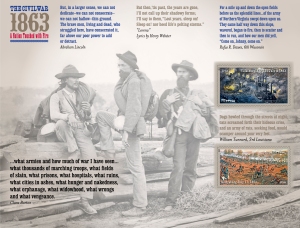This week marks the 150th anniversary of the Battle of Gettysburg, the largest battle of the Civil War and the first major defeat for Confederate general Robert E. Lee. Estimates of the three-day toll for both sides exceed 45,000 casualties, including more than 7,500 killed or mortally wounded.

The Battle of Gettysburg stamp is a reproduction of an 1887 chromolithograph by Thure de Thulstrup (1848-1930), a Swedish-born artist who became an illustrator for Harper’s Weekly after the Civil War. Thulstrup’s work was one of a series of popular prints commissioned in the 1880s by Boston publisher Louis Prang & Co. to commemorate the Civil War.
In the spring of 1863, General Lee had conceived a bold plan to invade Pennsylvania and perhaps deal a decisive blow to the Union. Fresh from his brilliant victory in Virginia at the Battle of Chancellorsville in early May, Lee confidently informed Confederate president Jefferson Davis that the invasion would relieve pressure on war-ravaged Virginia as well as on Rebel forces in the West.
Notwithstanding Lee’s optimism that he could follow up his recent triumph with a major offensive, the position of the South was increasingly desperate. Union forces were closing in on Vicksburg, Mississippi, jeopardizing the entire western theater. The Confederates sorely needed an offsetting victory in the East.
In early June, Lee began moving troops from his Army of Northern Virginia out of Fredericksburg. Before the end of the month, the bulk of the army had crossed the Potomac River into Maryland on their way to Pennsylvania. As Union forces discerned Lee’s intent, they raced north to meet the threat.
On June 28, President Abraham Lincoln, still seeking an aggressive general who could defeat Lee on the battlefield, replaced Joseph Hooker after his disappointing performance at Chancellorsville and put Maj. Gen. George Gordon Meade in command of the Army of the Potomac. Meade developed a plan to fight a defensive battle in Maryland, but the armies collided instead along the ridges and hills near the small town of Gettysburg, Pennsylvania.
Each of these envelopes carries one of the two Forever® stamps depicting significant conflicts of 1863—Battle of Gettysburg and Battle of Vicksburg—cancelled with an official First Day of Issue color postmark. Click the image for details.
The battle began on July 1, when a Confederate infantry division approached Gettysburg, stumbling prematurely into a Union cavalry division on McPherson’s Ridge, west of the town. Lee planned to engage Meade’s army only after massing his own scattered troops. However, unaware that Meade’s 90,000 Federal troops were only a short distance behind the Yankee cavalry, the Confederates attacked and the fighting quickly escalated. By the time Lee actually arrived on the scene, his troops had pushed the Federals back to Cemetery Hill, just south of the town. Lee ordered General Richard Ewell to seize the high ground “if practicable.” But as the sun was setting, Ewell decided it was too risky to attack. Union troops were then able to consolidate their position on Cemetery Hill during the night.
Meade arrived on the scene during the night and quickly decided that Cemetery Hill, and the ridge that ran southward from it, made a good defensive position. With most of Meade’s army arriving the next morning, July 2, the Union troops formed a line whose shape resembled a fishhook, with the curved part of the hook on Culp’s and Cemetery Hills and the shank running along Cemetery Ridge to the Round Tops. Lee’s most trusted subordinate, James Longstreet, recognizing the strength of the position, urged Lee to make a flanking move and find defensive terrain farther south of Gettysburg, but Lee was determined to stay on the offensive. Pointing to the Union line, he told Longstreet, “The enemy is there, and I am going to attack him there.” The ensuing attack on the afternoon of July 2 resulted in bloody fighting at places soon known across the nation as the Peach Orchard, Little Round Top, and Devil’s Den.
The following day (July 3), Lee ordered the ill-fated attack commonly known as Pickett’s Charge (after the lead officer, General George E. Pickett) on the Union center at Cemetery Ridge. Some 13,000 infantry crossed an open field under heavy artillery fire, incurring high casualties in an attempt to overrun the Union’s position. At the end of the day, Lee admitted his mistake, telling one of his generals, “All this has been my fault.” He ordered a retreat on July 4, the same day Vicksburg fell to Ulysses S. Grant in the West.
 For the Union’s much-maligned Army of the Potomac, the battle marked an important turning point. For Lee’s forces and the South, Gettysburg has often been called the “high water mark of the Rebellion.”
For the Union’s much-maligned Army of the Potomac, the battle marked an important turning point. For Lee’s forces and the South, Gettysburg has often been called the “high water mark of the Rebellion.”
The Civil War: 1863 souvenir sheet, featuring 12 self-adhesive Forever® stamps commemorating the Battle of Gettysburg and the Battle of Vicksburg (6 stamps of each design), is , by calling (), and in Post Offices nationwide. Forever stamps are always equal in value to the current First-Class Mail® one-ounce rate.



